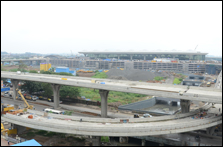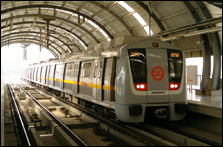 — Parvesh Minocha, Group Managing Director – Transportation Business, Feedback Infra Pvt. Ltd
— Parvesh Minocha, Group Managing Director – Transportation Business, Feedback Infra Pvt. Ltd
It has become quite difficult to implement road-based public transportation projects such as bus rapid transit and light rail transit systems owing to lack of sufficient space. Therefore, modes such as metro rail have become the need of the hour. While these projects require heavy investments, they provide a reliable, safe, cost-effective and eco-friendly means of routine transportation, Parvesh Minocha tells Lalitha Rao in this interview.
What do you expect from the new government for the urban transport segment that has faced challenges in recent years?
Due to a delayed National Urban Transport Policy and sufficient investments, the urban transport segment in the country has not been able to keep pace with the needs of a fast growing population. The absence of decent public transport facilities is resulting in more and more people switching to private vehicles, and this trend is further translating into traffic congestion, delays and pollution.
 Today, it has become quite difficult to implement road-based public transportation projects such as BRT and LRT owing to lack of sufficient space. Therefore, modes such as metro rail have become the need of the hour. These projects require heavy investments but provide for a reliable, safe, cost-effective and eco-friendly means of routine transportation.
Today, it has become quite difficult to implement road-based public transportation projects such as BRT and LRT owing to lack of sufficient space. Therefore, modes such as metro rail have become the need of the hour. These projects require heavy investments but provide for a reliable, safe, cost-effective and eco-friendly means of routine transportation.
The new government is expected to boost investments in the public transportation systems which can cater to the needs of a growing population in metropolitans, Tier I & II cities, keeping in mind a horizon of 15-20 years. Also, there is a need to pay special attention to convenience and safety of pedestrians, bicyclists and differently-abled people.
What policy amendments would you like to suggest for smoother and faster completion of projects?
Transportation projects mainly get delayed due to lack of comprehensive planning, good programme management, timely approvals and finance. Onerous contractual conditions also create issues in project execution and delivery.
I would like to suggest that procurement procedures are amended to be fair and transparent, and should be based on both quality and cost. Suitable amendments in current policies should be made to provide timely approvals. Also, a provision of dedicated ring-fenced urban transport fund could ensure that basic transport facilities are provided in urban areas.
For medium to large projects, investments from the private sector need to be encouraged by enabling policy framework as the response from the private sector in urban transport has been mixed.
Do you think metro projects are viable in India?
 No project in the world, no metro project in the world, on its own and just for fare box collection can act financially. There are several functions where they have to provide safe mode of public transportation in a time-bound manner. This is typically subsidised directly or through real estate or through some other development or through some other concession by the state. The metro project, even if you are sitting in Hong Kong where there is a lot of development, mostly use very small space but you can see the capital end of the project.
No project in the world, no metro project in the world, on its own and just for fare box collection can act financially. There are several functions where they have to provide safe mode of public transportation in a time-bound manner. This is typically subsidised directly or through real estate or through some other development or through some other concession by the state. The metro project, even if you are sitting in Hong Kong where there is a lot of development, mostly use very small space but you can see the capital end of the project.
What are the opportunities you look forward to for Indian transport infrastructure companies?
Global companies keep coming for high end consulting and higher equipment, hardware and software. So, if you look at the bidding norms, in the prequalification for the consultant, only global companies will be qualified. Indian companies would only partner global companies, which have large prequalification experience and profile; whereas Indian companies are still building it.
Why are major projects being delayed or stalled with less interest shown in tenders?
There are two issues. One is the viability of the bid itself. In the last two years, the bids have been uneconomical and unviable. As cash flows are not sustainable, they are not able to bring in equity. Therefore, these projects are stalled. Second is delay in getting clearances and issues like acquisition of land and removal of utility in urban areas by the concerned authority, which is a big issue.
What challenges do you face in the metro rail sector compared to, say, airports and ports?
The port consulting is done by Indian companies. Unlike in metro projects, where only global companies are prequalified, in the port sector both local and global companies are involved in the bids and are qualified; whereas in airports also, Indian companies are being qualified. In metro projects, to meet the prerequisite of the prequalification is a vast task. Thus, Indian companies fail to meet this prerequisite. The challenge is to align with companies who have this experience. Because of the recession in Europe, Indian companies do have possibilities in venturing into these projects. The main challenge is how we can upgrade our skills to the level of the global companies.
What is your perspective on the development of the Indian port sector in connection to rail connectivity for cargo movement?
The port sector is the only sector which is developing very well in the last two years. However, rail connect ivy is a major issue. Railways has not sorted out the agreements and revenue sharing and methodology. The major bottleneck is port connectivity by rail because road is not an option for large cargo movement. Railways does not have surplus funds to execute these projects and their policies are not clear.
How do you rate the success of the PPP model in metro rail? Do you feel that EPC mode (employed for Delhi Metro) is suited for India?
There is no successful project in PPP till now. All the PPP projects in metro sector are not that successful, such as Mumbai Metro which is still going through negotiation with the government over some issues. Gurgaon Metro has its own issues. If the PPP modal is not successful, the only other option available is EPC mode.
As member of the Sam Pitroda committee on modernisation of Indian Railways, what are your views for positive development in the railway sector other than metro and monorail?
In think, in the railways there are three remedies which have been approved by the committee including tariff which has to be fixed as the actual cost and not as subsidised cost; PPP can be brought in Railways to improve the infrastructure and technology. Technology, from locomotives to signalling systems, has to be upgraded. All these are equally important. It requires a change in policy, regulator, and reforms for successful and positive development in railway projects.
Overall, how do you rate India’s success in harnessing private capital and enterprise through the PPP model in transport infrastructure development?
Government should look at the power sector which is not moving at all as distribution companies do not have the money to pay the producers who in turn are unable to invest and are short of coal linkages. The government should debottleneck every issue. Each sector is facing one or the other issue; for instance, port sector has tariff fixation and port connectivity, railways has PPP and tariff fixation and modernisation, and road sector has concession agreement and land issues.
In fact, whatever PPP projects that have been implemented in India so far, from airports to roads, have actually been pretty good. Overall, India has done a good job in harnessing private capital through PPP model. In the next four to five years, India will see 8 to 9 per cent growth. India will remain the third largest economy in the world. Technology is going to play a big role in infrastructure space.











